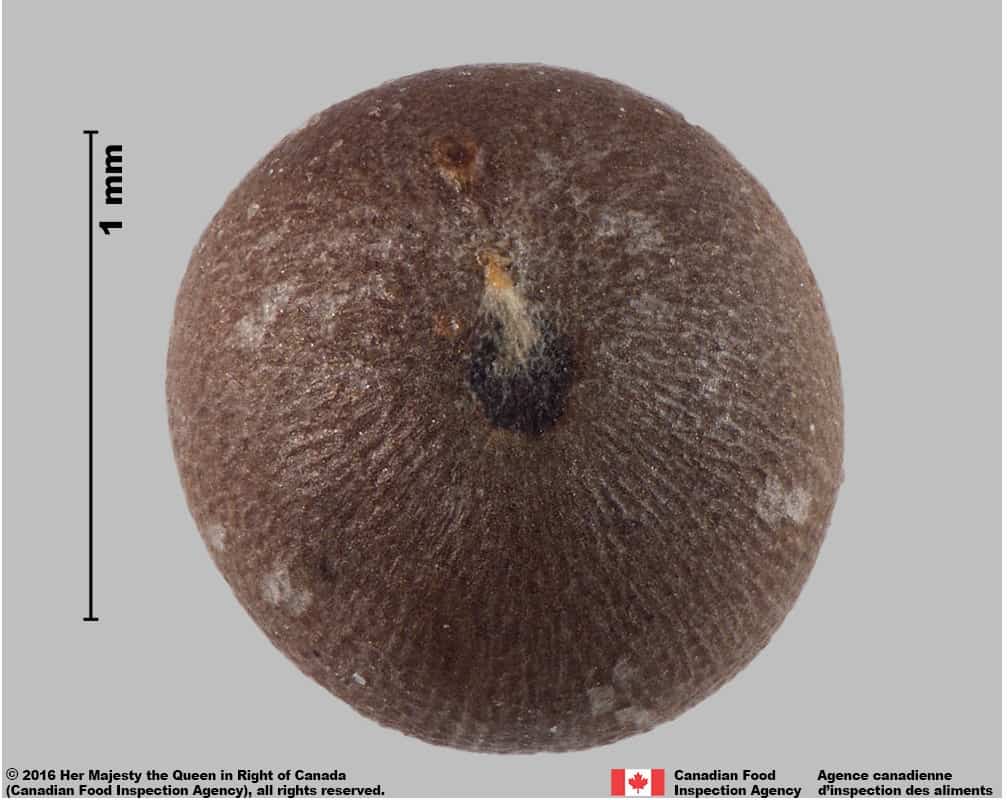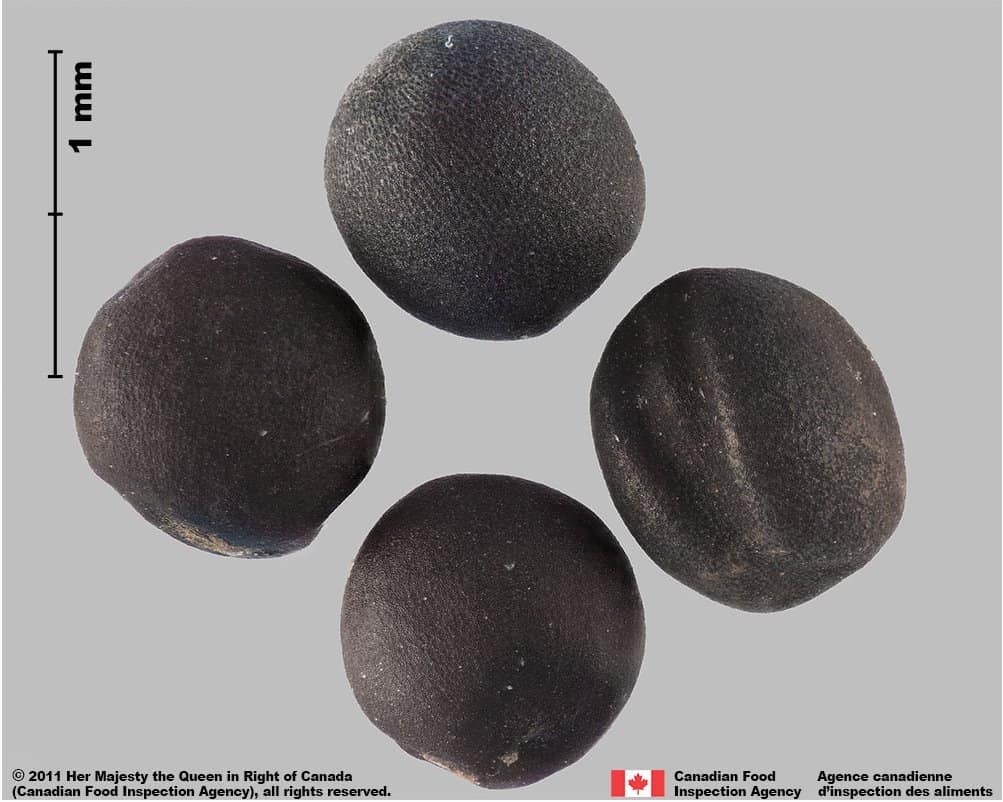Sinapis arvensis subsp. arvensis
Overview
Aperçu
Regulation :
Remarques Réglementation:
- CFIA Weed Seeds Order - Class 3: Secondary Noxious Weed Seeds
Regulation Notes:
Distribution :
Répartition :
Native to northern Africa, Europe and temperate Asia and introduced in North and South America, southern Africa, Japan, Australia and New Zealand (USDA-ARS 2021). Widespread in the United States (USDA-NRCS 2021). Occurs throughout Canada except in Nunavut (Brouillet et al. 2010+).
Habitat and Crop Association :
Habitat et Cultures Associées :
Cultivated fields, fallow fields, gardens, clearings, orchards, shores, riverbanks, roadsides, railway lines and disturbed areas (Warwick et al. 2000; Darbyshire 2003). A serious weed of field crops in the Canadian prairies, especially in Brassica napus subsp. napus (canola) (Royer and Dickinson 1999; Warwick et al. 2000).
Economic Use, cultivation area, and Weed Association :
Utilisation économique, zone de culture et association de mauvaises herbes :
Duration of Life Cycle :
Durée du cycle vital:
Annual
Dispersal Unit Type :
Type d’unité de dispersion :
Seed
General Information
RENSEIGNEMENTS GÉNÉRAUX
Sinapis arvensis subsp. arvensis was documented in crops in New York State as early as 1748 and had reached Nova Scotia by 1829 (Mulligan and Bailey 1975), but may have been present in North America before European contact (Warwick et al. 2000). Individual plants are capable of producing 2,000 to 3,500 seeds that can remain viable in soil for up to 60 years (Warwick et al. 2000). Both the seeds and leaves of this plant contain glucosinolates that are capable of causing severe illness in livestock (Warwick et al. 2000).
.
Sinapis arvensis infestation (L.L. Berry, Bugwood.org)
Identification
Identification
-
Silique
Size
- Silique length: 20.0 – 45.0 mm long; width: 2.5 – 3.5 mm (FNA 1993+)
Shape
- Silique is cylindrical and terete
Surface Texture
- Silique surface glabrous or rarely hairy
Colour
- Silique dull yellow coloured
Other Features
- Silique shiny green coloured when immature
- A persistent style is at the end of the silique 10.0 – 16.0 mm long, may contain 1 seed (FNA 1993+)

Wild mustard (Sinapis arvensis) pod

-
Seed
Size
- Seed diameter*: 1.3 – 1.9 mm
*Note: minimum and maximum of 10 seeds in a normal range of this species using image measurement (ISMA 2020)
Shape
- Globose, often slightly compressed at hilum area
Surface Texture
- Seed surface with ridged reticulations that generally radiate out from the hilum
Colour
- Seeds generally shiny black, can also be reddish-brown, brown or greenish-brown
- Ridged reticulations are generally lighter than the surface colour
Other Features
Hilum & Hilum area
- Hilum area is black coloured area, round, generally only visible on brown coloured seeds
- A small warty tubercle and short line of white tissue are visible near the hilum area
Other
- Seed mucilaginous when wetted (FNA 1993+)

Wild mustard (Sinapis arvensis) seeds





-
Embryo
Size
- Embryo fills the seed
Shape
- Embryo is simple folded
Endosperm
- Endosperm is scant or lacking, nutritive tissue contained within cotyledons
Other Features
- Cotyledons are round or oval shaped, soft and yellow coloured
Identification Tips
CONSEILS POUR L’IDENTIFICATION
Seeds of Brassicaceae species that are globose shaped, such as Brassica rapa, B. napus, Sinapis alba, and S. arvensis subsp. arvensis can be distinguished primarily by colour, shape, surface reticulations, and degree of stippling. S. arvensis subsp. arvensis seeds differ from other Brassica species in the spherical shape, a small hilum or hilum area not visible, radiating reticulation pattern, and the appearance of shallow surface pitting.

Wild mustard (Sinapis arvensis) seed





Additional Botany Information
AUTRES RENSEIGNEMENTS BOTANIQUES

Sinapis arvensis flowers (Mourad Louadfel, Retired, Bugwood.org)

Similar Species
ESPÈCES SEMBLABLES
Similar species are based on a study of seed morphology of various species, and those with similar dispersal units are identified. The study is limited by physical specimen and literature availability at the time of examination, and possibly impacted by the subjectivity of the authors based on their knowledge and experience. Providing similar species information for seed identification is to make users aware of similarities that could possibly result in misidentification.
Brassica napus L. subsp. napus (Argentine canola )
B. napus subsp. napus seeds are generally angular in outline with a large, black, D-shaped hilum area, while S. arvensis subsp. arvensis seed is spherical and has a small and round hilum area with a warty tubercle. B. napus subsp. napus has a stippled surface with a ‘sparkling’ look that S. arvensis subsp. arvensis seed lacks.
Click to select species
Cliquez pour sélectionner les espèces

Brassica napus subsp. napus
Comparison Window
Fenêtre de comparaison
MAIN SPECIES
ESPÈCES PRINCIPALES
Sinapis arvensis subsp. arvensis

Sinapis arvensis subsp. arvensis
Brassicaceae
Wild mustard (Sinapis arvensis) seeds
MAIN SPECIES
ESPÈCES PRINCIPALES
Sinapis arvensis subsp. arvensis

Sinapis arvensis subsp. arvensis
Brassicaceae
Wild mustard (Sinapis arvensis) seeds
MAIN SPECIES
ESPÈCES PRINCIPALES
Sinapis arvensis subsp. arvensis

Sinapis arvensis subsp. arvensis
Brassicaceae
Wild mustard (Sinapis arvensis) seed, hilum view
MAIN SPECIES
ESPÈCES PRINCIPALES
Sinapis arvensis subsp. arvensis

Sinapis arvensis subsp. arvensis
Brassicaceae
Wild mustard (Sinapis arvensis) seed
MAIN SPECIES
ESPÈCES PRINCIPALES
Sinapis arvensis subsp. arvensis

Sinapis arvensis subsp. arvensis
Brassicaceae
Wild mustard (Sinapis arvensis) seed
MAIN SPECIES
ESPÈCES PRINCIPALES
Sinapis arvensis subsp. arvensis

Sinapis arvensis subsp. arvensis
Brassicaceae
Wild mustard (Sinapis arvensis) pod
SIMILAR SPECIES
ESPÈCES SEMBLABLES
Brassica napus subsp. napus

Brassica napus subsp. napus
Brassicaceae
Argentine rapeseed (Brassica napus subsp. napus) seeds
SIMILAR SPECIES
ESPÈCES SEMBLABLES
Brassica napus subsp. napus

Brassica napus subsp. napus
Brassicaceae
Argentine rapeseed (Brassica napus subsp. napus) seeds
SIMILAR SPECIES
ESPÈCES SEMBLABLES
Brassica napus subsp. napus

Brassica napus subsp. napus
Brassicaceae
Argentine rapeseed (Brassica napus subsp. napus) seed
SIMILAR SPECIES
ESPÈCES SEMBLABLES
Brassica napus subsp. napus

Brassica napus subsp. napus
Brassicaceae
Argentine rapeseed (Brassica napus subsp. napus) seed, hilum view
Need ID Help?
Besoin d’aide pour l’identification?
Reference(s)
Référence(s)
Brouillet, L., Coursol, F., Meades, S. J., Favreau, M., Anions, M., Bélisle, P. and Desmet, P. 2010+. VASCAN, the database of vascular plants of Canada. http://data.canadensys.net/vascan/ Accessed April 27, 2021.
Centre for Agriculture and Bioscience International (CABI). 2021. Invasive Species Compendium, CAB International, Wallingford, UK. https://www.cabidigitallibrary.org/journal/cabicompendium Accessed April 27, 2021.
Darbyshire, S. J. 2003. Inventory of Canadian Agricultural Weeds. Agriculture and Agri-Food Canada, Research Branch. Ottawa, ON.
Flora of North America (FNA) Editorial Committee, eds. 1993+. Flora of North America North of Mexico [Online]. 22+ vols. New York and Oxford. Accessed December 29, 2022.
Global Biodiversity Information Facility (GBIF) Secretariat. 2022. https://doi.org/10.15468/39omei Accessed via https://www.gbif.org/species/3047598 Accessed December 29, 2022.
Government of Canada (GC). 2016. Canadian Weed Seeds Order. https://laws-lois.justice.gc.ca/eng/regulations/SOR-2016-93/page-2.html (English) https://laws-lois.justice.gc.ca/fra/reglements/DORS-2016-93/page-2.html (French)
International Seed Morphology Association (ISMA). 2020. Method for Seed Size Measurement. Version 1.0. ISMA Publication Guide.
Mulligan, G. A. and Bailey, L. N. 1975. The biology of Canadian weeds. 8. Sinapis arvensis L. Canadian Journal of Plant Science 55: 171-183.
Royer, F. and Dickinson, R. 1999. Weeds of Canada and the Northern United States. The University of Alberta Press/Lone Pine Publishing, Edmonton, Alberta.
U.S. Department of Agriculture-Agricultural Research Services (USDA-ARS). 2021. Germplasm Resources Information Network (GRIN), https://npgsweb.ars-grin.gov/gringlobal/taxon/taxonomysimple.aspx Accessed April 27, 2021.
U.S. Department of Agriculture-Natural Resources Conservation Service (USDA-NRCS). 2021. The PLANTS Database. National Plant Data Team, Greensboro, NC USA. http://plants.usda.gov Accessed April 27, 2021.
Warwick, S. I., Beckie, H. J., Thomas, A. G. and McDonald, T. 2000. The biology of Canadian weeds. 8. Sinapis arvensis L. (updated). Canadian Journal of Plant Science 80: 939-961.




